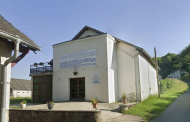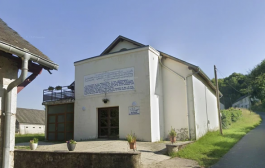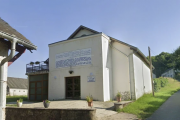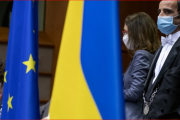Annalisa Malara, a 38-year-old anaesthetist at Codogno hospital in the northern Lombardy region, was horrified when she saw the image of the lungs of Mattia Maestri, an otherwise fit and healthy person of the same age, as he underwent a CT scan on the morning of 20 February.
– within less than 48 hours his pneumonia had transformed from being something small into something devastating,” she said. “But the idea that this patient could be infected with such severity really threw me – he was young, healthy and athletic. However, this is also what helped to make the diagnosis as the case was so striking.”
Malara was looking at the lungs of Italy’s “patient 1”, the first confirmed case of domestic transmission of the virus in a country where it would go on to kill nearly 29,000 people. Until that day, Malara said, the coronavirus seemed like something that was so remote, only happening in China and other Asian countries as the rest of the world watched from a distance.
“Yes, we had guidelines and we spoke about it, but nobody could ever have imagined that it would spread so much in Italy,” she said.
Testing at the time was only for those who had returned from China, and Malara had to bend the guidelines to order a Covid-19 swab for Maestri. When the result came back it prompted both the closure of the hospital’s emergency wing and a government order to quarantine the entire town south of Milan, marking Europe’s first coronavirus lockdown.
Maestri had had symptoms typical of coronavirus – a fever, cough and shortness of breath – for about 10 days before he first visited the hospital. An initial X-ray showed there was slight pneumonia on his right lung. He was given antibiotics and asked if he wanted to stay in hospital, but he declined. His symptoms worsened and a few hours later he returned and was immediately admitted and given oxygen therapy. Malara was called by her colleagues for advice during Maestri’s CT scan.
Another detail that prompted the test emerged during a conversation with Maestri’s wife, who was eight months pregnant. Maestri had told doctors several times that his last trip abroad was to New York in September but his wife then recalled that a few weeks earlier he was at a dinner with a colleague who had recently returned from China. The colleague did not present any symptoms at the time and tested negative for the virus.
A patient in a biocontainment unit is carried on a stretcher from an ambulance into the Columbus Covid 2 hospital in Rome.
FacebookTwitterPinterest A patient in a bio-containment unit is carried on a stretcher from an ambulance into the Columbus Covid 2 hospital in Rome. Photograph: Alessandra Tarantino/AP
The diagnosis caught the whole of Italy off-guard, despite the country’s first cases being detected in late January, when two Chinese tourists tested positive in Rome. During the intervening period, life had mostly carried on as usual. There was the occasional report of an Italian “possibly” having the virus, only for it to turn out to be a false alarm.
Two days after Codogno was quarantined, nine other Lombardy towns went into lockdown, along with one in the Veneto region, where Italy’s first coronavirus death occurred.
Massimo Galli, the director of infectious diseases at the Luigi Sacco hospital in Milan, said in the week after the diagnosis that the virus may have been circulating in the quarantined areas of northern Italy for weeks before it was detected by Malara’s test.
Maestri recovered, as did his wife and the two Chinese visitors. Malara has spoken to Maestri over the phone, and said he is doing well. He became a father a few weeks ago. But tragically, before he was discharged from hospital his father died of Covid-19 in his hometown of Castiglione d’Adda.
The horror of the outbreak is revealed
On 3 March, Costantino Pesatori, the mayor of Castiglione d’Adda, one of the 10 quarantined towns, posted a video appeal for help. Up until that point, most people in Italy were still very confused about the largely unknown threat, at that time mainly known in the west through reports from China. The virus was killing people and beginning to overwhelm hospitals, but the early deaths seemed to reflect a similar pattern: older people with underlying health issues.
While leaders of some towns and cities were encouraging citizens to fight against the fear – by going to bars, restaurants and shops – Pesatori knew better.
“I knew straight away how serious it was because from the day the epidemic was discovered in Codogno people in my town were dying,” he said. “If you consider two or three people a day dying in a town of 4,600, this is not normal.”
Pesatori’s plea revealed details of the virus’s devastating impact, which until then had mostly been under the radar. Eighteen people died in the town within less than a fortnight, including a 55-year-old man with no known underlying illnesses. With three of the town’s five doctors quarantined and two in hospital, there was nobody to tend to those who were sick at home.
“The situation was really worrying,” Pesatori said. “I understood that this was something new and difficult to manage, but many mayors were without support and because people elsewhere didn’t understand how serious things were, they felt they were free to carry on as normal.”
Two military doctors were sent to the town on 11 March, two days after the whole of Lombardy was quarantined, a move that prompted thousands to flee south. It was also the day Italy became the first country to enforce a nationwide lockdown. By that stage, 827 people in Italy had died and more than 12,000 were infected. It was a move many had believed could never be ordered in a democracy without the means to coerce its citizens, but within weeks it was replicated across the continent and worldwide as the number of deaths rose.
As Pesatori struggled to help his citizens, his family was struck: his mother, who died on 25 March, is among the town’s 76 fatalities.
“I learned through all of this that you have to hold your nerve,” he said. “Despite my pain I had to look forward, for our future generation but also to ensure health is protected.”
Although people are still in hospital, both the emergency and contagion rate have subsided. “But the virus is still circulating, and so we can’t completely drop our guard,” said Pesatori.
While attention was focused on Codogno during the first two weeks of its confirmed outbreak, a more discrete drama was unfolding in Bergamo, a province north of Milan. The first case of coronavirus was detected at a hospital in Alzano Lombardo on 23 February, but Bergamo only went into lockdown with the rest of the Lombardy region on 8 March. It quickly became Italy’s most severely affected province.
No more beds in Bergamo
“There are no more beds here.” These were the last words Ettore Consonni, 61, a retired warehouse worker, heard before slipping into a coma at a hospital in Bergamo.
Back in Italy, he began developing the Covid-19 symptoms of fever and shortness of breath. A test confirmed the worst.
At that stage of the outbreak, well-resourced hospitals across Lombardy and in the second worst-affected region of Emilia-Romagna were struggling to cope, with intensive care beds dwindling as the infection spread.
In an attempt to manage the emergency, sick people were placed in operating rooms or hospital corridors, while others were airlifted on military planes to southern Italy.
When Consonni awoke after 23 days in a coma, he was in Sicily.
“I thought it was a joke,” he said. “I fell asleep in Bergamo, my city in the extreme north, and I woke up in Palermo, in the deep south. I heard accents among the medical staff, but I thought it was simply the many Sicilian health professionals who work in Bergamo. Then they took me to the window and I saw it was no joke.”
Consonni shared a ward at the Benfratelli hospital with other patients from the north. “The doctors told me I almost died,” he said. “That’s why I’m glad I don’t remember anything from those days.”
Eventually discharged from intensive care, by early April he was breathing normally. A second test came back negative and on 21 April Consonni left hospital amid resounding applause.
Consonni arrived home to more applause from family and neighbours, despite noticing a peculiar look on their faces. “I knew something really bad had happened. My wife sat me down and told me that my brother had died of Covid-19.”
Consonni realised that while he was fighting for his life, life in Bergamo had descended into heartbreak. Doctors compared the situation to war, with one medic claiming that saving a life was decided by age and health conditions.
The sirens never stopped, church bells rang for each of the dead. Coffins stacked up in churches and, with cemeteries full, some were taken by military truck for burial in neighbouring regions. The corpses of those who had died at home were kept in sealed-off rooms for days as undertakers struggled to cope.
“He died in my mother’s arms as I was on the telephone, trying to get help,” said Asia Marchesi, 24. “Watching him struggling to breathe was like watching somebody drown.”
Her father, Siro, is one of many who died at home, a silent toll which, as with deaths in care homes, has not been recorded in the official statistics.
It is thought the 64-year-old may have contracted Covid-19 on 22 February, when he visited the emergency unit of a hospital in Bergamo city for a foot infection.
“He had to take an antibiotic for that but it wasn’t anything serious, after a week he was better,” his daughter said.
He then travelled to the family’s second home in Liguria, but returned to Bergamo on 6 March after he started to feel unwell.
“From the moment he became ill the nightmare began.” Asia Marchesi made frantic calls to helpline numbers and as she waited for a response, she could hear her father’s breathing getting worse. His GP visited and prescribed an antibiotic. Despite presenting all the symptoms and being immunosuppressed, no coronavirus test was done.
He died on 13 March, and his body was kept at home for one-and-a-half days, covered with a sheet, while the family waited for a doctor to certify the death. As with many other deaths at home or in residential care, no postmortem test was done for Covid-19.
Asia Marchesi struggled not to cry as she described her father. “Until the last moment, all he kept saying was: ‘Asia, stop calling the doctors, I don’t want to disturb them.’”
She added: “There is some comfort that we were with him at the end, as so many people die alone in hospital, but he died such a terrible death. We felt abandoned.”
With funerals banned and physical distancing in place, she, her mother and two siblings who live nearby were unable to be physically comforted by relatives and friends, amplifying their grief. “We couldn’t even … receive a hug.”
Marchesi has joined NOI Denunceremo (We Will Denounce), a Facebook group for relatives of victims who are seeking justice.
“People have lost their loved ones unjustly,” she said. “Even if these are difficult economic times I do not want financial compensation as it won’t bring my father back. What I want is for whoever made a mistake to take responsibility.”
In normal times Milan is Italy’s business and fashion hub. The Lombardy capital started to empty out soon after the outbreak began in Codogno but it did not go into quarantine until 9 March.
The only vehicles speeding through the normally clogged streets during lockdown have been ambulances, especially at night, when 33-year-old Matteo Derai joins the hundreds of volunteers responding to callouts. Eighty per cent of the calls during the peak were for suspected Covid-19.
“Nobody is forcing me to do this, but above all in these moments we must be courageous,” he said. “Only when my shift is over do I realise that I haven’t slept for 24 hours.”
His partner, Fosca, is a nurse on maternity leave who cares for their newborn son, Tommaso. When Derai returns home, after shuttling suspected Covid-19 patients around hospitals, he lives with the fear of bringing the virus home to his family.
“If before the outbreak, I tried to support people emotionally as well, now, when you are so concerned about your own safety, you let this human connection slip.”
One, Derai said, was a woman who had lost her husband. “She told us that what struck her most was the silence without him and that she may beheading towards the same destiny.”
He does not know whether the dozens of patients he brought to hospital lived or died. His duty ends when they are admitted.
“At the beginning, I was curious to know if the mothers, fathers, husbands and grandmothers I had met and spoken to while on the way to the hospital had recovered from Covid-19.
“Then as I saw the number of deaths rise day after day, I stopped wondering and preferred to live with the hope that everyone made it through alive. Even if I knew it probably wasn’t true.”
After almost two months under lockdown, the longest so far of any European country, Italy will begin slowly easing restrictions on 4 May. But as the health emergency subsides, the next major challenge will be the economic one.
The forecast is bleak. Experts predict a crisis not seen in decades. While industry across the country will resume from Monday, most retailers will not reopen until 18 May, while bars and restaurants – the backbone of the economy of so many Italian towns – will stay closed until 1 June. Many small businesses may never reopen.
Her livelihood depends on a vibrant street culture. “I live for gatherings,” she said. “Without people around me, my work is over. I’m at risk of extinction.
“I dedicated the last six years of my life to become a street performer, but Covid-19 may take it all away.”
The government has allocated €3.3bn (£2.9bn) for workers at small companies, but this may not be enough. The first sign of economic upheaval came towards the end of March, when reports emerged of social unrest in Italy’s poorer south and people stealing from supermarkets after they ran out of food and money.
Red Cross volunteers now deliver food to those in need but the mafia has also reportedly been exploiting the situation by distributing food parcels to the poorest districts of southern Italy.
Thousands in the months ahead risk unemployment. And with summer on its way the pandemic will have a devastating impact on tourism, a crucial contributor to Italy’s economy, risking closure for hotels, bars, restaurants and tourist services.
A few days into lockdown, people across Italy sang and played music from their balconies as they came together to say: “Andrà tutto bene” (Everything will be all right). But lives have changed over the last few months, and a different saying is gathering momentum: “No,” Ira said. “Everything will not be all right.”







































admin in: How the Muslim Brotherhood betrayed Saudi Arabia?
Great article with insight ...
https://www.viagrapascherfr.com/achat-sildenafil-pfizer-tarif/ in: Cross-region cooperation between anti-terrorism agencies needed
Hello there, just became aware of your blog through Google, and found ...